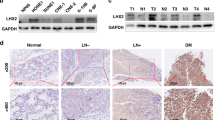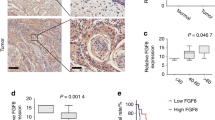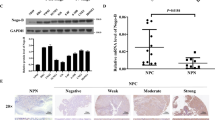Abstract
Fibulin-2 (FBLN2) has been identified as a candidate tumor-suppressor gene in nasopharyngeal carcinoma (NPC). Originally identified through a chromosome 3 NotI genomic microarray screen, it shows frequent deletion or methylation in NPC. FBLN2 is located on chromosome 3p25.1 and is associated with tumor development through its important interactions with the extracellular matrix (ECM) proteins. FBLN2 encodes two isoforms. The short isoform (FBLN2S) is expressed abundantly in normal tissues, but is dramatically downregulated in NPC, while the long isoform (FBLN2L) is either not detectable or is expressed only at low levels in both normal and tumor tissues. Reintroduction of this FBLN2S inhibited cell proliferation, migration, invasion and angiogenesis in vitro. Furthermore, in vivo studies in nude mice show its expression is associated with tumor and angiogenesis suppression. FBLN2-associated angiogenesis occurs via concomitant downregulation of vascular endothelial growth factor and matrix metalloproteinase 2. This study provides compelling evidence that FBLN2S has an important tumor-suppressive and anti-angiogenic role in NPC.
This is a preview of subscription content, access via your institution
Access options
Subscribe to this journal
Receive 50 print issues and online access
$259.00 per year
only $5.18 per issue
Buy this article
- Purchase on Springer Link
- Instant access to full article PDF
Prices may be subject to local taxes which are calculated during checkout





Similar content being viewed by others
Abbreviations
- Dox:
-
doxycycline
- ECM:
-
extracellular matrix
- FBLN2S:
-
short fibulin-2 isoform
- FBLN2:
-
fibulin-2
- FBLN2L:
-
long fibulin-2 isoform
- MCH:
-
microcell hybrid
- MI:
-
methylation index
- NPC:
-
nasopharyngeal carcinoma
- Q–PCR:
-
quantitative RT–PCR
- TSG:
-
tumor-suppressor gene
References
Chattopadhyay I, Singh A, Phukan R, Purkayastha J, Kataki A, Mahanta J et al. (2010). Genome-wide analysis of chromosomal alterations in patients with esophageal squamous cell carcinoma exposed to tobacco and betel quid from high-risk area in India. Mutat Res 696: 130–138.
Cheng Y, Poulos NE, Lung ML, Hampton G, Ou B, Lerman MI et al. (1998). Functional evidence for a nasopharyngeal carcinoma tumor suppressor gene that maps at chromosome 3p21.3. Proc Natl Acad Sci USA 95: 3042–3047.
Cheung AK, Lung HL, Hung SC, Law EW, Cheng Y, Yau WL et al. (2008). Functional analysis of a cell cycle-associated, tumor-suppressive gene, protein tyrosine phosphatase receptor type G, in nasopharyngeal carcinoma. Cancer Res 68: 8137–8145.
Cheung AK, Lung HL, Ko JM, Cheng Y, Stanbridge EJ, Zabarovsky ER et al. (2009). Chromosome 14 transfer and functional studies identify a candidate tumor suppressor gene, mirror image polydactyly 1, in nasopharyngeal carcinoma. Proc Natl Acad Sci USA 106: 14478–14483.
de Vega S, Iwamoto T, Yamada Y . (2009). Fibulins: multiple roles in matrix structures and tissue functions. Cell Mol Life Sci 66: 1890–1902.
Dunwell TL, Hesson LB, Pavlova T, Zabarovska V, Kashuba V, Catchpoole D et al. (2009). Epigenetic analysis of childhood acute lymphoblastic leukemia. Epigenetics 4: 185–193.
Fassler R, Sasaki T, Timpl R, Chu ML, Werner S . (1996). Differential regulation of fibulin, tenascin-C, and nidogen expression during wound healing of normal and glucocorticoid-treated mice. Exp Cell Res 222: 111–116.
Gallagher WM, Currid CA, Whelan LC . (2005). Fibulins and cancer: friend or foe? Trends Mol Med 11: 336–340.
Grassel S, Sicot FX, Gotta S, Chu ML . (1999). Mouse fibulin-2 gene. Complete exon-intron organization and promoter characterization. Eur J Biochem 263: 471–477.
Hanahan D, Weinberg RA . (2000). The hallmarks of cancer. Cell 100: 57–70.
Hill VK, Hesson LB, Dansranjavin T, Dallol A, Bieche I, Vacher S et al. (2010). Identification of 5 novel genes methylated in breast and other epithelial cancers. Mol Cancer 9: 51.
Li HM, Man C, Jin Y, Deng W, Yip YL, Feng HC et al. (2006). Molecular and cytogenetic changes involved in the immortalization of nasopharyngeal epithelial cells by telomerase. Int J Cancer 119: 1567–1576.
Li J, Protopopov A, Wang F, Senchenko V, Petushkov V, Vorontsova O et al. (2002). NotI subtraction and NotI-specific microarrays to detect copy number and methylation changes in whole genomes. Proc Natl Acad Sci USA 99: 10724–10729.
Libra M, Scalisi A, Vella N, Clementi S, Sorio R, Stivala F et al. (2009). Uterine cervical carcinoma: role of matrix metalloproteinases (review). Int J Oncol 34: 897–903.
Lo PH, Lung HL, Cheung AK, Apte SS, Chan KW, Kwong FM et al. (2010). Extracellular protease ADAMTS9 suppresses esophageal and nasopharyngeal carcinoma tumor formation by inhibiting angiogenesis. Cancer Res 70: 5567–5576.
Lung HL, Cheung AK, Cheng Y, Kwong FM, Lo PH, Law EW et al. (2010). Functional characterization of THY1 as a tumor suppressor gene with antiinvasive activity in nasopharyngeal carcinoma. Int J Cancer 127: 304–312.
Lung HL, Cheung AK, Xie D, Cheng Y, Kwong FM, Murakami Y et al. (2006). TSLC1 is a tumor suppressor gene associated with metastasis in nasopharyngeal carcinoma. Cancer Res 66: 9385–9392.
McDonnell S, Matrisian LM . (1990). Stromelysin in tumor progression and metastasis. Cancer Metastasis Rev 9: 305–319.
Mutirangura A, Tanunyutthawongese C, Pornthanakasem W, Kerekhanjanarong V, Sriuranpong V, Yenrudi S et al. (1997). Genomic alterations in nasopharyngeal carcinoma: loss of heterozygosity and Epstein-Barr virus infection. Br J Cancer 76: 770–776.
Nakao M, Kawauchi S, Uchiyama T, Adachi J, Ito H, Chochi Y et al. (2011). DNA copy number aberrations associated with the clinicopathological features of colorectal cancers: Identification of genomic biomarkers by array-based comparative genomic hybridization. Oncol Rep 25: 1603–1611.
Pan TC, Sasaki T, Zhang RZ, Fassler R, Timpl M, Chu RL . (1993). Structure and expression of fibulin-2, a novel extracellular matrix protein with multiple EGF-like repeats and consensus motifs for calcium binding. J Cell Biol 123: 1269–1277.
Pfaff M, Sasaki T, Tangemann K, Chu ML, Timpl R . (1995). Integrin-binding and cell-adhesion studies of fibulins reveal a particular affinity for alpha IIb beta 3. Exp Cell Res 219: 87–92.
Protopopov AI, Li J, Winberg G, Gizatullin RZ, Kashuba VI, Klein G et al. (2002). Human cell lines engineered for tetracycline-regulated expression of tumor suppressor candidate genes from a frequently affected chromosomal region, 3p21. J Gene Med 4: 397–406.
Rathinam R, Alahari SK . (2010). Important role of integrins in the cancer biology. Cancer Metastasis Rev 29: 223–237.
Senchenko VN, Liu J, Loginov W, Bazov I, Angeloni D, Seryogin Y et al. (2004). Discovery of frequent homozygous deletions in chromosome 3p21.3 LUCA and AP20 regions in renal, lung and breast carcinomas. Oncogene 23: 5719–5728.
Strom A, Olin AI, Aspberg A, Hultgardh-Nilsson A . (2006). Fibulin-2 is present in murine vascular lesions and is important for smooth muscle cell migration. Cardiovasc Res 69: 755–763.
Tsuda T, Wang H, Timpl R, Chu ML . (2001). Fibulin-2 expression marks transformed mesenchymal cells in developing cardiac valves, aortic arch vessels, and coronary vessels. Dev Dyn 222: 89–100.
Wu Y, Dai J, Schmuckler NG, Bakdash N, Yoder MC, Overall CM et al. (2010). Cleaved high molecular weight kininogen inhibits tube formation of endothelial progenitor cells via suppression of matrix metalloproteinase 2. J Thromb Haemost 8: 185–193.
Yau WL, Lung HL, Zabarovsky ER, Lerman MI, Sham JS, Chua DT et al. (2006). Functional studies of the chromosome 3p21.3 candidate tumor suppressor gene BLU/ZMYND10 in nasopharyngeal carcinoma. Int J Cancer 119: 2821–2826.
Yi CH, Smith DJ, West WW, Hollingsworth MA . (2007). Loss of fibulin-2 expression is associated with breast cancer progression. Am J Pathol 170: 1535–1545.
Zhang H, Tsao SW, Jin C, Strombeck B, Yuen PW, Kwong YL et al. (2004). Sequential cytogenetic and molecular cytogenetic characterization of an SV40T-immortalized nasopharyngeal cell line transformed by Epstein-Barr virus latent membrane protein-1 gene. Cancer Genet Cytogenet 150: 144–152.
Zhang HY, Chu ML, Pan TC, Sasaki T, Timpl P, Ekblom R . (1995). Extracellular matrix protein fibulin-2 is expressed in the embryonic endocardial cushion tissue and is a prominent component of valves in adult heart. Dev Biol 167: 18–26.
Acknowledgements
This work was supported by University Grants Council Area of Excellence grant AoE/M-06/08 to MLL and the Swedish Cancer Society, the Swedish Research Council, the Swedish Institute, and Karolinska Institute to ERZ.
Author information
Authors and Affiliations
Corresponding author
Ethics declarations
Competing interests
The authors declare no conflict of interest.
Additional information
Supplementary Information accompanies the paper on the Oncogene website
Rights and permissions
About this article
Cite this article
Law, E., Cheung, A., Kashuba, V. et al. Anti-angiogenic and tumor-suppressive roles of candidate tumor-suppressor gene, Fibulin-2, in nasopharyngeal carcinoma. Oncogene 31, 728–738 (2012). https://doi.org/10.1038/onc.2011.272
Received:
Revised:
Accepted:
Published:
Issue Date:
DOI: https://doi.org/10.1038/onc.2011.272
Keywords
This article is cited by
-
A novel prognostic signature of seven genes for the prediction in patients with thymoma
Journal of Cancer Research and Clinical Oncology (2019)
-
The expression level of fibulin-2 in the circulating RNA (ctRNA) of epithelial tumor cells of peripheral blood and tumor tissue of patients with metastatic lung cancer
Molecular Biology Reports (2019)
-
Fibulin-2 is required for basement membrane integrity of mammary epithelium
Scientific Reports (2018)
-
ISOexpresso: a web-based platform for isoform-level expression analysis in human cancer
BMC Genomics (2016)
-
Fibulin-4 is associated with tumor progression and a poor prognosis in ovarian carcinomas
BMC Cancer (2015)



